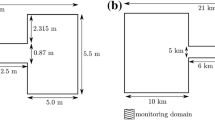Abstract
This paper presents a surface particle image velocimetry study to investigate the dynamics of shallow starting-jet dipoles formed by tidal flow through inlets and their interaction with vorticity formed at the inlet channel lateral boundaries. Vortical structure in the flow field is identified using a local swirl strength criterion evaluated from the two-dimensional flow field. The starting jet dipole vortices and vortices formed as the lateral boundary layers are expelled during flow reversal are characterized by their trajectory, size, and circulation. Using these quantities, a model is developed to predict the size and strength of the expelled lateral boundary layer vortices based on the inlet velocity, channel length, and width of the lateral boundary layer. The expelled boundary layer vortices are found to disrupt the formation of the primary tidal jet dipole through two mechanisms. First, because the boundary layer vortices themselves form a dipole with each half of the starting-jet dipole, the starting-jet vortices are pulled apart and advected away from the inlet mouth early in the tidal cycle, resulting in a reduction in the spin-up time and the amount of vorticity input during starting-jet vortex formation. Second, the advection of each dipole away from the inlet disconnects each starting-jet vortex from the starting jet; hence, the vortices are not fed by fluid in the jet or energized by shear in the jet boundary layers. These influences of the lateral boundary layer on the starting-jet vortices’ formation and propagation are found to be a function of the channel length L, maximum velocity U, and tidal period T, resulting in a predictive value to characterize their trajectory, strength, and evolution.
Similar content being viewed by others
Abbreviations
- δ :
-
Boundary layer width
- Δ:
-
Lateral displacement
- ΓE :
-
Boundary layer circulation
- ΓS :
-
Starting-jet vortex circulation
- ω :
-
Vorticity
- ν :
-
Kinematic viscosity
- d :
-
Velocity gradient tensor
- D :
-
Turbulent diffusion coefficient
- h :
-
Water depth
- K w :
-
Inlet strouhal number
- L :
-
Channel length
- p :
-
Vortex radius
- l s :
-
Sink length scale
- l j :
-
Jet excursion length scale
- T :
-
Tidal period
- t s :
-
Vortex spin-up time
- Reh :
-
Reynolds Number
- U :
-
Maximum tidal velocity
- W :
-
Inlet Width
References
Roughan M, Mace AJ, Largier JL, Morgan SG, Fisher JL, Carter ML (2005) Subsurface recirculation and larval retention in the lee of a small headland: a variation on the upwelling shadow theme. J Geophys Res-Oceans 110(C10): 18
Chadwick DB, Largier JL (1999) The influence of tidal range on the exchange between San Diego Bay and the ocean. J Geophys Res-Oceans 104: 29885–29899
Van Senden DC, Imberger J (1990) Effects of initial conditions and Ekman suction on tidal outflows from inlets. J Geophys Res-Oceans 95: 13373–13391
Wells MG, van Heijst GJF (2003) A model of tidal flushing of an estuary by dipole formation. Dyn Atmos Oceans 37: 223–244
Nicolau del Roure F, Socolofsky SA, Chang K-A (2009) Structure and evolution of tidal starting-jet vortices at idealized barotropic inlets. J Geophys Res-Oceans, C05024
Jirka GH (2001) Large scale flow structures and mixing process in shallow flows. J Hydraul Res 39(6): 567–573
Signell RP, Geyer WR (1991) Transient eddy formation around headlands. J Geophys Res-Oceans 96: 2561–2575
Pawlak G, MacCready P, Edwards KA, McCabe R (2003) Observations on the evolution of tidal vorticity at a stratified deep water headland. Geophys Res Lett 30(24): 2234
Geyer RW, Signell R (1990) Measurements of tidal flow around a headland with a shipboard acoustic Doppler profiler. J Geophys Res-Oceans 95: 3189–3197
Geyer RW (1993) Three-dimensional tidal flow around headlands. J Geophys Res-Oceans 98: 955–966
Old CP, Vennell R (2001) Acoustic Doppler current profiler measurements of the velocity field of an ebb tidal jet. J Geophys Res-Oceans 106: 7037–7049
Kovacevic V, Gacic M, Mosquera IM, Mazzoldi A, Marinetti S (2004) HF radar observations in the northern Adriatic: surface current field in front of the Venetian Lagoon. J Marine Syst 51: 95–122
Amoroso RO, Gagliardini DA (2010) Inferring complex hydrographic processes using remote-sensed images: turbulent fluxes in the Patagonian Gulfs and implication for scallop metapopulation dynamics. J Coast Res 26: 320–332
Kim DH, Lynett PJ, Socolofsky SA (2009) A depth-integrated model for weakly dispersive, turbulent, and rotational flows. Ocean Model 27: 198–214
Lin J–C, Ozgoren M, Rockwell D (2003) Space time development of the onset of a shallow-water vortex. J Fluid Mech 485: 33–66
Kashiwai M (1985a) TIDICS-control of tidal residual circulation and tidal exchange in a channel-basin system. J Oceanogr Soc Jpn 41: 1–10
Kashiwai M (1985b) A hydraulic experiment on tidal exchange. J Oceanogr Soc Jpn 41: 11–24
Nicolau del Roure F (2007) Laboratory studies of eddy structures and exchange processes through tidal inlets. M. S. Thesis, Ocean Engineering Program, Texas A&M University, College Station
Socolofsky SA, Jirka GH (2004) Large-scale flow structures and stability in shallow flows. J Environ Eng Sci 3(5): 451–462
Adrian RJ, Christensen KT, Liu ZC (2000) Analysis and interpretation of instantaneous turbulent velocity fields. Exp Fluids 29: 275–290
Raffel M, Willert CE, Kompenhans J (1998) Particle image velocimetry: a practical guide, New York
Jean M, Julian S (2000) An introduction to turbulent flow, New York
Fischer HB, List EJ, Koh RCY, Imberger J, Brooks NH (1979) Mixing in inland and coastal waters. Academic Press, New York
Author information
Authors and Affiliations
Corresponding author
Rights and permissions
About this article
Cite this article
Bryant, D.B., Whilden, K.A., Socolofsky, S.A. et al. Formation of tidal starting-jet vortices through idealized barotropic inlets with finite length. Environ Fluid Mech 12, 301–319 (2012). https://doi.org/10.1007/s10652-012-9237-4
Received:
Accepted:
Published:
Issue Date:
DOI: https://doi.org/10.1007/s10652-012-9237-4




